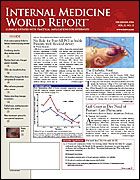Publication
Article
Internal Medicine World Report
New Conjugated Estrogen Treatments for Postmenopausal Women
Author(s):
From the American Society for Reproductive Medicine
NEW ORLEANS—How to treat postmenopausal symptoms remains a confusing issue for many physicians since the results of the Women’s Health Initiative raised concerns about the safety of hormone replacement therapy. But postmenopausal symptoms have not gone away, and researchers have been investigating alternative therapies.
Two studies presented at the American Society for Reproductive Medicine annual meeting focus on 2 potential new treatments for postmenopausal symptoms.
Vulvovaginal Atrophy
A recent randomized, multicenter, double-blind, placebo-controlled trial investigated the benefit of oral synthetic conjugated estrogen (SCE)-B (Enjuvia) for the treatment of vulvovaginal atrophy, another common symptom in postmenopausal women. This agent is the second SCE product available in this country for the treatment of vasomotor symptoms, including hot flashes, sweating, and sleep disturbances, in older women.
The study included 310 women (mean age, 59 years) with at least 1 symptom of moderate or severe vaginal atrophy. They were randomized to placebo (n = 125) or to SCE-B, 0.3 mg/day (n = 123), for 12 weeks. Investigators measured mean changes in vaginal maturation index, vaginal pH, and patient-rated severity of the most bothersome symptoms; typical complaints included vaginal dryness, irritation/dryness, soreness, dyspareunia, bleeding after intercourse, and difficulty urinating.
P
At 12 weeks, women receiving SCE-B had a 6-fold greater improvement in the vaginal maturation index than those receiving placebo ( <.001). They also had a significant increase in the percentage of superficial mucosal cells and a corresponding decrease in the percentage of parabasal cells, reported lead investigator James A. Simon, MD, of George Washington University, Washington, DC.
P
At baseline, vaginal dryness or dyspareunia was listed as the most bothersome symptom in 44.4% of women randomized to SCE-B and 30.2% of those receiving placebo. At the end of the study, more than twice as many SCE-B recipients said that the severity of their most bothersome symptom had significantly decreased compared with placebo recipients. They also had a significant decrease in mean vaginal pH compared with placebo (1.69 vs 0.45; <.001). At baseline, mean vaginal pH was approximately 6.7 in both groups.
The incidence of adverse effects with SCE-B was only 3%, which was comparable to that in the placebo group.
Investigators concluded that one 0.3-mg tablet of SCE-B daily is effective for symptomatic vulvovaginal atrophy in postmenopausal women.
Peter McGovern, MD, director, Division of Reproductive Endocrinology and Infertility, New Jersey Medical School, Newark, commented, “This is a small, early trial, and it is premature to draw any definitive conclusions about safety, but [Enjuvia] certainly seems to be efficacious” for vulvovaginal atrophy.
Novel Combo Therapy: TSEC Drugs
Another study was presented by lead investigator Dyonne Van Duren, MD, PhD, director of Menox BV, the Netherlands. She outlined a potential new approach to treating postmenopausal symptoms by combining a selective estrogen receptor modulator (SERM) and conjugated estrogens into a new class of tissue-selective estrogen complex (TSEC) agents.
In this study, the combination of the investigational SERM bazedoxifene (Wyeth) and conjugated estrogens proved to be an effective alternative to traditional postmenopausal hormone therapy. Bazedoxifene, currently under FDA review, was designed for the prevention of osteoporosis; like other SERMs, bazedoxifene targets estrogen receptors and may selectively inhibit or stimulate estrogenlike action in target tissues.
Investigators reasoned that the SERM/conjugated estrogen combination would result in a new TSEC product that would maximize the benefits of estrogen therapy while minimizing its adverse effects. “We want to maintain bone mineral density without stimulating endometrial proliferation, and ideally we want an agent that does not stimulate breast tissue proliferation,” Vivian Lewis, MD, Department of Reproductive Endocrinology, University of Rochester Medical Center, New York, told IMWR.
The primary objective of this double-blind, placebo-controlled study was to investigate the effect of bazedoxifene plus conjugated estrogens on the endometrium. Investigators randomized 408 women who were at least 1 year postmenopausal, had an endometrial thickness <5 mm, and had an average of ≥4 hot flashes daily.
Participants were randomized to daily treatment with bazedoxifene 5, 10, or 20 mg, paired with conjugated estrogens, 0.3 or 0.625 mg. Five control groups received placebo, conjugated estrogens 0.3 mg, conjugated estrogens 0.625 mg, bazedoxifene 5 mg alone, or conjugated estrogens 0.625 mg plus medroxyprogesterone acetate 2.5 mg.
Endometrial thickness was measured by transvaginal ultrasound at baseline and on days 28 and 84. The mean weekly number of hot flashes and the incidence of amenorrhea were recorded in a daily diary, and physical examinations and lab tests were used to assess safety.
The combination bazedoxifene/conjugated estrogens resulted in less change in endometrial thickness, as well as a reduced frequency of hot flashes. “Overall, with this combination the change in endometrial thickness was significantly lower at day 84, and…the incidence of bleeding and spotting was very low. So this is a convenience factor that would appeal to women,” Dr Van Duren said.
Hot flashes were significantly reduced with a number of treatments. But all doses of the combination produced a significantly greater reduction in the frequency of hot flashes compared with all control groups.
David Barad, MD, director of assisted reproductive technology, Center for Human Reproduction, New York City, commented, “This is a very important study, because SERMs have created symptomatic problems. We’re not going to find a ‘single-molecule’ solution, so we’re going to blend them and get something that, on the whole, will be better.” He predicted that such combinations will be the focus of future research.






